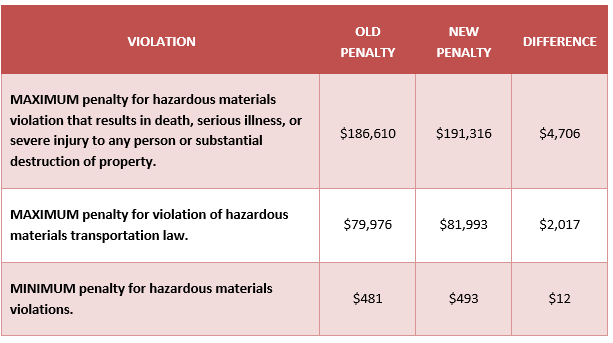
As Labelmaster Staff Regulatory Specialist Nikki Burgess reported a couple of weeks back, many federal agencies recently raised their civil penalties about 2.5% for Dangerous Goods regulatory citations.
In other words, any compliance errors you make will now cost you a little more.
Update! On October 29, 2019, penalties at many agencies were increased an additional 2.5% to reflect inflation pressures. See the new penalties here.
Since most readers of this blog—and most players in the global hazmat supply chain—take compliance extremely seriously, we don’t usually discuss civil penalties and other consequences of non-compliance. You would probably keep your shipments compliant for safety alone, even if there were no penalties at all.
Yet, even the most conscientious operations often don’t account for the full impact of compliance gaps on their companies’ bottom lines. With penalties going up—and the potential impact becoming that much greater—now is a good time to revisit the Total Value of Compliance framework.
A closer look at the new penalty levels
But first … just how much are those penalties going up, anyway?
You can review all the new penalties in the Federal Register, but here are the key FAA and PHMSA citations that apply to Dangerous Goods shipments:

The maximum penalties are terrifying, as they should be. In practice, however, they’re reserved for the most serious and most egregious violations, and while they may always be in the backs of our minds as a worst-case scenario, they aren’t a matter of daily concern for the conscientious hazmat operation.
It’s the minimum penalties that can actually make the biggest difference, because they’re the ones that can take a big bite out of your profitability without anyone really noticing.
Real bottom-line losses
The minimum penalty went up 12 dollars. Big deal, right?
Actually, yes. One of the most common Dangerous Goods violations, incurred by even the best-intentioned organizations, is a missing or outdated training certification. That penalty is assessed per employee, per day, so if you happen to have two employees whose certifications are found to be 10 days overdue, the penalties add up:
2 employees x 10 days = 20 days
20 days x $493 = $9,860 (which is $240 more than last year)
According to Burgess, the most common PHMSA violations are:
- Non-current training certifications
- Failure to identify hazardous materials and/or misclassification of such materials
- Incorrect use of UN packaging (usually not following the closure instructions)
- Marking and labeling errors
- Shipping paper mistakes
- Expired cylinder test certifications
- Failure to have a required registration
These common violations may only happen here and there, but $493 here and $493 there add up to real, bottom-line losses.
But does anyone notice or keep track of these losses? In many cases, the answer is “no.”
Transparency about civil penalties
In many Dangerous Goods operations, the people who pay the penalties are in a different office from the people who manage the actual shipping. Or a different building. Or a different state.
There’s nothing inherently wrong with that arrangement, as long as there’s complete and accurate transparency between the two. But if you don’t have that transparency, you have no way to truly gauge your operation’s performance. If you’re not aware of the true costs of the civil penalties you incur, you can’t assess your operation’s ROI.
And if you can’t demonstrate ROI to your company’s management, you can’t justify the investment you need to make compliance a competitive advantage.
Our Total Value of Compliance framework can help you improve your organizational transparency, so you (and your management) can get a complete picture of your operation’s costs. Maybe those occasional civil penalties don’t add up to much—or maybe they’re a hidden cost that’s hurting the company’s earnings. Shouldn’t you know?
With new levels of civil penalties in force, now is a great time to start that conversation.
Discover your total value of compliance.
Make sure your shipments are safe and in complete compliance with a full line of solutions from Labelmaster—a full-service provider of goods and services for hazardous materials and Dangerous Goods professionals, shippers, transport operators and EH&S providers.



I don’t think the maximum is much more than the ‘reduced’ penalty in the death of the three longshoremen who died while working on the M/V Madelaine in Miami. ‘Be a (manager, CEO, president, vice president, chairman), go to jail.’ These penalties can hurt a mom and pop operation but not a corporation or multi national. Please.
Second in the list of most common violations is “failure to identify”, also known as “undeclared”. Each undeclared shipment is something like 17 different violations (e.g. no PSN on paperwork, no ID# on paperwork, no PG on paperwork, not in the right order, no certification, no ERG, et al, and that’s just the shipping papers!). 17 x nearly $200K per violation is over $3,000,000.00, per day it was in transport, so penalties can hurt even big companies.